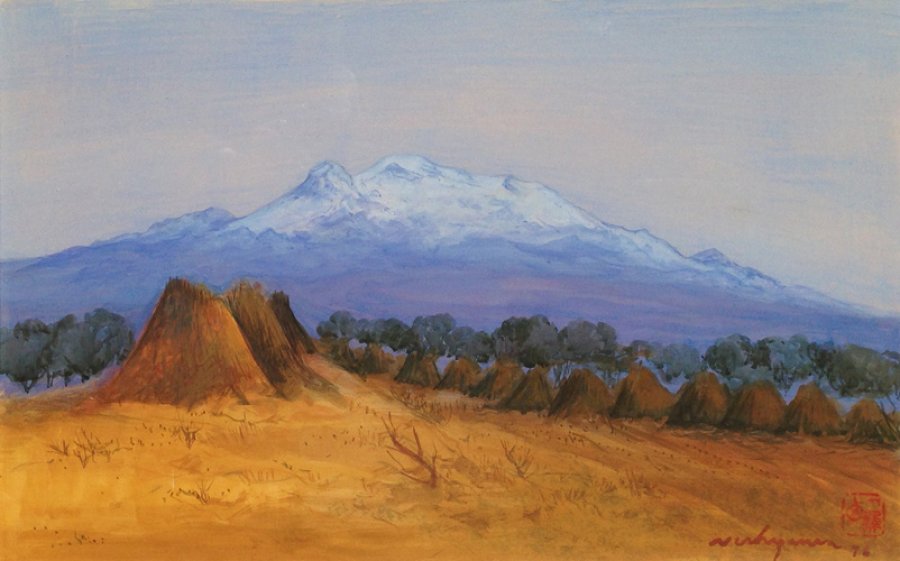Noticias
Second death anniversary on Thursday September 29th
Luis Nishizawa, the painter of beauty, nature and color
September 28, 2016Luis Nishizawa Flores (Cuautitlan, State of Mexico, February 2, 1918 - Toluca, State of Mexico, September 29, 2014) was a Mexican painter who enriched Mexico’s art and culture from several areas, he was a painter, ceramist, draftsman, stained glass artist, engraver, muralist and sculptor, but also a writer, teacher and a tenacious cultural promoter.
Son of a Japanese father, Kenji Nishizawa and a Mexican mother, Maria de Jesus Flores, he merged in his art these two cultures that gave rise to hundreds of works or windows- as Luis Nishizawa said- that allow people who look at the picture "to dive in it and be part of my adventures and beyond they like them, they feel them”.
“A shy child at school who liked to draw”, that is how Luis Nishizawa’s friends and relatives remember him, he was an artist of realism, expressionism, gestural, abstractionism, conceptual and figurative art.
"My father taught me a great discipline and my mother, sensitivity. Two values that have been pillars in my life and in my work”, Luis Nishizawa said at the time, who was also influenced by Francisco Goitia, Cézanne, Modigliani, Rembrandt, Luis Sahagún and Alfredo Zalce.
His work covers almost all techniques, and highlights in lithography, watercolor, oil, tempera, etching, ink, engraving, Ukiyo-e (woodcut), Japanese print, glass, ceramics and wax.
"He was an expert in the use of artistic techniques. A teacher in methodologies and procedures of painting for 55 years and a painter who dominated all genres highlighting the portrait and landscape”.
"He dabbled in expressionism, the Mexican School of Painting, he painted still life and made abstractions, although he is known for his landscapes, but he also made drawings and murals in different parts of the country and abroad”, Úrsula Cotero García Luna, director of Luis Nishizawa Museum Workshop, explained.
In Luis Nishizawa’s work you can see portrayed the reality interwoven with dreams, the most intimate memories of his childhood, his relationship with nature and the Mexican countryside, seasons, landscape, sky, man, woman, children, folk traditions, genre paintings, still lifes and his travels.
He also recreated his friends and his parents, the animals who referred him back to his childhood as a shepherd, poetry, Juan Rulfo’s work, gestures, faces, mountains, fish, shrimp, nudes, flowers, fruits and the colors he always was passionate about: black, white and yellow.
"His paintings reflect his childhood in the countryside, he was passionate about nature and started to draw since he was four. They also express the peace that the environment gave him and he portrayed social issues witnessed in Tepito, where he lived, so there are faces that reflect poverty, folk art and traditions.
"He is the heir of the Japanese and Mexican philosophy; he was a researcher of the Nahuatl and Japanese world and used its symbolism in his work, which is full of great beauty, an emotional language of color and excellent techniques that can last more than 400 years and leave us proof of a portrayed Mexico for over 70 years”, Ursula Cotero added.
Luis Nishizawa’s production also includes books: Maya (1969), Artesanía de México (Mexico’s handcrafts) (1972) and México mágico (Magic Mexico) (1989), in addition to the murals he made with the use of stone, ceramics, tile and glass, which reflected among other things, pre-Hispanic symbolism, morbidity and health care, like in El aire es vida (Air is life), made for the Medical Center of the Mexican Social Security Institute.
He also created works such as: Un canto a la vida (A song to life), at the Social Security Unit in Celaya, Guanajuato; Un canto a Martí (A song to Martí), at the José Martí Cultural Center; El lecho del universo (The bed of the universe), at the Museum of Modern Art Mexiquense Cultural Center, and El espíritu creador siempre se renueva (The creative spirit always renews), at the train station of Keisei in Japan.
"His last works are interesting, especially because he showed new techniques such as the use of glass not as a stained glass, but as a mural. Also because they show he used many techniques with his way of evolving, he first worked more traditional techniques and then ended with the glass he used in a very interesting way”, painter, engraver and muralist Rina Lazo said.
Luis Nishizawa was a teacher at the National School of Plastic Arts of the National Autonomous University of Mexico (1955-2003); college counselor (1989-1993), plus holder of the Coghlan chair of the College of Sinaloa (2000).
To Rina Lazo, this facet as a teacher was one of Nishizawa’s contributions made for Mexico’s culture, because he was a great teacher who guided students and professors about techniques, especially oil painting and tempera.
"He liked to teach and tell all his secrets on techniques and that was his most important contribution. We were contemporaries, I asked him once about the technique of tempera and we talked about it, but I mostly saw that he had great patience to teach, make art and share his knowledge with the students”, he explained.
Luis Nishizawa was a member of The Ateneo State of Mexico, the Mexican Society of Geography and Statistics in the State of Mexico and of the Academy of Arts.
He received several awards and distinctions, among which are: the Imperial Award of Japan: Sacred Treasure, the José María Velasco State of Mexico Prize (1984) and the National Prize for Arts and Sciences (1996).
He was Creator Emeritus of the National System of Art Creators of Fonca (National Fund for Culture and Arts), Doctor Honoris Causa of UNAM and received the Fine Arts Medal (2013).
Since December 1992, in Toluca, State of Mexico, there is the Museum-Workshop that bears his name in recognition of the teaching work he did in the training of young painters for over four decades and for his huge artistic creation.
Mexico,Distrito Federal
